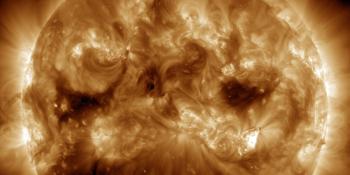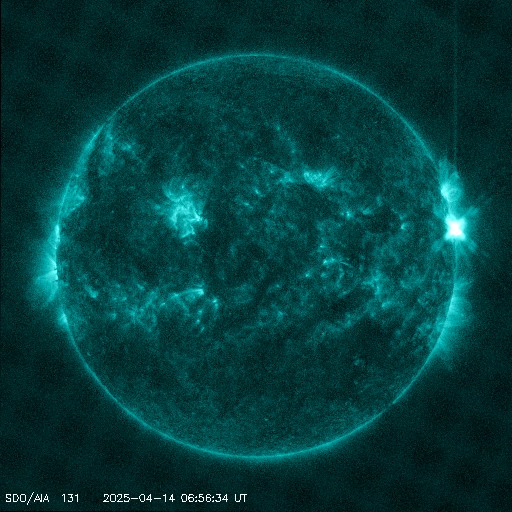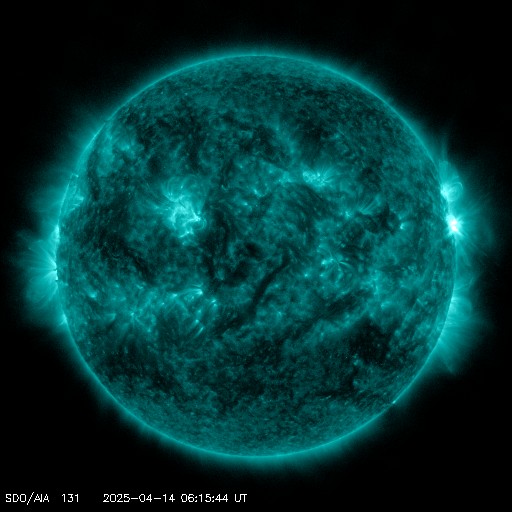Viewing archive of Thursday, 25 August 2011
Solar activity report
Any mentioned solar flare in this report has a scaling factor applied by the Space Weather Prediction Center (SWPC). Because of the SWPC scaling factor, solar flares are reported as 42% smaller than for the science quality data. The scaling factor has been removed from our archived solar flare data to reflect the true physical units.
Report of Solar-Geophysical Activity 2011 Aug 25 2200 UTCPrepared by the NOAA © SWPC and processed by SpaceWeatherLive.com
Joint USAF/NOAA Report of Solar and Geophysical Activity
SDF Number 237 Issued at 2200Z on 25 Aug 2011IA. Analysis of Solar Active Regions and Activity from 24-2100Z to 25-2100Z
Solar activity was at very low levels. Region 1271
(N17W56) decayed in area and spot count, but developed a Delta
magnetic configuration in the large leader spot. The region produced
numerous low-level B-class events. Three new regions were numbered
during the period. In the western hemisphere, new Region 1278
(N16W40) emerged as a simple 4-spot bi-polar group. On the eastern
limb, new Region 1277 (N17E62) and new Region 1279 (N14E75) both
rotated onto the disk as large, uni-polar H-type groups. Region 1277
produced a B9 x-ray event at 25/0702Z while Region 1279 produced
another B9 x-ray event at 25/1652Z. The SOHO LASCO satellite
observed a slow-moving CME off the east limb, first observed in C2
imagery at 25/0856Z with an estimated plane-of-sky speed of 420
km/s. This CME does not appear to have an Earthward directed
component.
IB. Solar Activity Forecast
Solar activity is expected to be low
with a slight chance for an M-class event all three days (26 - 28
August).
IIA. Geophysical Activity Summary 24-2100Z to 25-2100Z
The geomagnetic field was at quiet levels. Observations from the ACE
spacecraft indicated a steady decline in solar wind velocity during
the period from about 500 km/s to near 400 km/s. The Bz component
of the interplanetary magnetic field did not vary much beyond +/- 4
nT while the phi angle remained negative (toward) throughout the
period.
IIB. Geophysical Activity Forecast
The geomagnetic field is
expected to remain at quiet levels for days one and two (26 - 27
August). By day three (28 August), activity levels are expected to
increase to quiet to unsettled, with isolated active periods, due to
a geoeffective, recurrent coronal hole high speed stream.
III. Event Probabilities 26 Aug to 28 Aug
| Class M | 10% | 10% | 10% |
| Class X | 01% | 01% | 01% |
| Proton | 01% | 01% | 01% |
| PCAF | Green | ||
IV. Penticton 10.7 cm Flux
Observed 25 Aug 104 Predicted 26 Aug-28 Aug 110/115/115 90 Day Mean 25 Aug 097
V. Geomagnetic A Indices
Observed Afr/Ap 24 Aug 005/006 Estimated Afr/Ap 25 Aug 005/005 Predicted Afr/Ap 26 Aug-28 Aug 005/005-005/005-007/010
VI. Geomagnetic Activity Probabilities 26 Aug to 28 Aug
| A. Middle Latitudes | |||
|---|---|---|---|
| Active | 15% | 15% | 20% |
| Minor storm | 01% | 01% | 05% |
| Major-severe storm | 01% | 01% | 01% |
| B. High Latitudes | |||
|---|---|---|---|
| Active | 15% | 15% | 30% |
| Minor storm | 01% | 01% | 15% |
| Major-severe storm | 01% | 01% | 01% |
All times in UTC
Current data suggests there is a slight possibility for aurora to appear at the following high latitude regions in the near future
TórshavnReykjavik
Luleå
Latest news
Latest forum messages
AR 4055 992025/04/12-13 Filament CMEs 2025/04/16 G2 Watch 38Incoming & Unnumbered Active Regions 1700Unspecified geomagnetic activity 2258Potential AR4062 8
More topicsSupport SpaceWeatherLive.com!
A lot of people come to SpaceWeatherLive to follow the Sun's activity or if there is aurora to be seen, but with more traffic comes higher server costs. Consider a donation if you enjoy SpaceWeatherLive so we can keep the website online!

Latest alerts
Monday, 14 April 2025
23:15 UTC - Geomagnetic activity
Active geomagnetic conditions (Kp4) Threshold Reached: 23:01 UTC
07:09 UTC - Solar flare
Moderate M4.28 flare from sunspot region 4055
06:48 UTC - Radio Blackout
Minor R1 radio blackout in progress (≥M1 - current: M1.53)
06:24 UTC - Solar flare
Moderate M1.49 flare from sunspot region 4055
06:06 UTC - Radio Blackout
Minor R1 radio blackout in progress (≥M1 - current: M1.16)
Space weather facts
| Last X-flare | 2025/03/28 | X1.1 |
| Last M-flare | 2025/04/14 | M4.2 |
| Last geomagnetic storm | 2025/04/06 | Kp5 (G1) |
| Spotless days | |
|---|---|
| Last spotless day | 2022/06/08 |
| Monthly mean Sunspot Number | |
|---|---|
| March 2025 | 134.2 -20.4 |
| April 2025 | 132.1 -2.1 |
| Last 30 days | 130.6 -13.6 |





